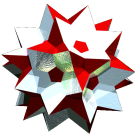apiculated cube
©
©
- at long edge: arccos(-4/5) = 143.130102°
- at short edge: arccos(-4/5) = 143.130102°
- general polytopal classes:
- Catalan polyhedra
links


| Acronym | tekah |
| Name |
tetrakis hexahedron, apiculated cube |
| |
| Inradius | 2/sqrt(5) = 0.894427 |
| Vertex figure | [t6], [T4] |
| Coordinates | |
| Dihedral angles |
|
| Dual | toe |
| Face vector | 14, 36, 24 |
| Confer |
|
|
External links |


|
The triangles {(t,t,T)} have vertex angles t = arccos(2/3) = 48.189685° resp. T = arccos(1/9) = 83.620630°.
Edge sizes used here are tT = x = 1 (short) resp. tt = b = 4/3 = 1.333333 (long).
A nice construction is shown at the right: Start with a small co of edge size 1/q. Apiculating its squares by according squippies results in an oct of edge size 2/q = q, thus already providing exactly the above provided second vertex type coordinates. Also apiculating its triangles by according tets will provide a tip-to-tip diagonal of 1/q ⋅ q/h (scaling × tet-height) + 1/q ⋅ 2q/h (scaling × co-height between parallel triangles) + 1/q ⋅ q/h (opposite tet) = 4/3 h, i.e. exactly the vertex-to-vertex diagonal of the here being used b-scaled cube, hence giving rise to the above given first set of coordinates. Thus m3m4o then is just the hull of that all-apiculated co, even within its correct metricallity.
Incidence matrix according to Dynkin symbol
m3m4o =
ao3oo4ob&#zx → height = 0
a = sqrt(2) = 1.414214
b = 4/3 = 1.333333
o.3o.4o. | 6 * | 4 0 | 4 [T4]
.o3.o4.o | * 8 | 3 3 | 6 [t6]
------------+-----+-------+---
oo3oo4oo&#x | 1 1 | 24 * | 2 x
.. .. .b | 0 2 | * 12 | 2 b
------------+-----+-------+---
.. .. ob&#x | 1 2 | 2 1 | 24 {(t,t,T)}
m3m3m =
coo3oao3ooc&#z(x,x,b) → height = 0
a = sqrt(2) = 1.414214
b = lacing(1,3) = 4/3 = 1.333333
c = 4 sqrt(2)/3 = 1.885618
o..3o..3o.. | 4 * * | 3 3 0 | 6 [t6]
.o.3.o.3.o. | * 6 * | 2 0 2 | 4 [T4]
..o3..o3..o | * * 4 | 0 3 3 | 6 [t6]
----------------------+-------+----------+---
oo.3oo.3oo.&#x | 1 1 0 | 12 * * | 2 x
o.o3o.o3o.o&#b | 1 0 1 | * 12 * | 2 b
.oo3.oo3.oo&#x | 0 1 1 | * * 12 | 2 x
----------------------+-------+----------+---
ooo3ooo3ooo&#r(x,x,b) | 1 1 1 | 1 1 1 | 24 {(t,t,T)}
© 2004-2025 | top of page |